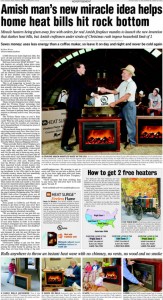As a copywriter, I get goosebumps from promos like the “Amish Miracle Fireplace” full page ad which has been running of late. This is the Ronco/Popiel school of long form copy I pored over when I was learning my trade. (In fact, I once interviewed at the Ronco offices in North Hollywood. I recall they had the various examples of their direct marketing prowess… the Veg-o-Matic, Pocket Fisherman and more… lined up on a shelf like Teddy Roosevelt’s African hunting trophies). As a cub copywriter I felt these ads were more audacious than deceptive… they were so entertaining in their own right that no one should feel cheated if they didn’t get their money’s worth.

The Amish Miracle Fireplace copywriter would have old Sam Popiel sitting up in his grave and saluting. The miracle is the heater being promoted in the ad, which puts out a high level of radiant heat for such a tiny object and will be yours FREE as long as you buy a wooden box/mantle to house it, which is the part made by the Amish. A little sleuthing gets to how the marketer makes money: At $300 plus shipping, the price of the box is much more than the apparent value of the “free” heater. But still. So many marketing touchpoints here: thrift, American tradition, pride of ownership in something that makes your hope more cozy, who wouldn’t want one at the bargain price of free?
Unfortunately, the folks at consumeraffairs.com have burst our bubble. Their article is a miraculous bit of digging, and along the way they respond to such consumer queries as “I thought Amish people didn’t use electricity” and “I thought Amish people didn’t allow themselves to be photographed.” They also tell us why such endorsements as UL-approved and the Good Housekeeping Seal of Approval are essentially meaningless. And they point out that a device that produces the same level of electric heat (while sending your utility bill through the roof, by the way) can be bought at Target for $20.
The vice president of the company that makes the heater is interviewed in the article, and he is delightfully unrepentant. The “miracle”, he explains, is actually the imitation flames that are displayed on the front screen of the heater. “These heaters are being called a miracle because they have what’s being called the ‘Fireless Flame’ patented technology that gives you the peaceful flicker of a real fire but without any flames, fumes, smells, ashes or mess. The patented ‘Fireless Flame’ looks so real it amazes everybody,” says David Baker, of Heat Surge in Canton, OH. I happened to have spent a weekend in Canton last fall and I wish I had had the presence of mind to check out this miracle for myself.
